THROTTLE CONTROL
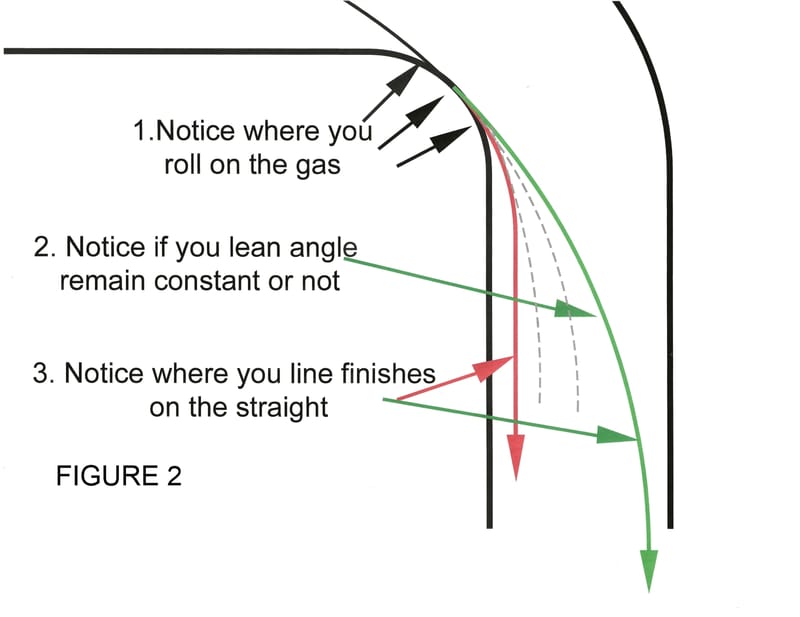
THROTTLE CONTROL
“Getting the best drive off the turn, before working on entry speed”
This is a step by step and comprehensive description of the techniques to develop an efficient and the best acceleration off the turn. Even though this is a simple task there are many variables to master, when trying to improve this task.
Throttle control is important. Riders must develop a technique that will allow as much throttle and as soon as possible, while maintaining control.
- Too much throttle and the rear wheel will spin excessively. This in turn will lead to the rear wheel stepping out too much and result in a possible crash.
- Too little or too late on the throttle will result in less acceleration on to the straight and a slower terminal speed by the end of the straight.
- Too soon on the gas and you could run off the track at the exit.
There is one concept you need to remember in throttle control, which is "Cause and Effect." The cause is the opening of the throttle, and the effect is your acceleration and exit line onto the straight.
There are two main aspects of good throttle control,
1. HOW MUCH
2. WHEN

Even though the results of the two are closely related, you must mentally separate the two when trying to make improvements in your drive off the turn. The following is a description on how to use these two mental tools.
The concepts or processes here are,
- Keep the lean angle the same, then any Increase “HOW MUCH” throttle will change the resulting exit line.
OR
- Maintain a constant speed or rate of acceleration, then any change of “WHEN”, to sooner or later, in and of itself, will not change the dimensions between different arches of the lines but, it will change their trajectory.
1. HOW MUCH
The main object is to apply as much power as possible. The amount of power to apply is limited by the available traction. As mentioned above, too much throttle and the rear wheel will spin excessively. This in turn will lead to the rear wheel stepping out too much and result in a possible crash. Too little or too late on the throttle will result in less acceleration on to the straight and a slower terminal speed by the end of the straight.
The only way to tell if you are using all of the traction, to spin the rear wheel SLIGHTLY as you exit the turn. Seldom is the throttle abruptly fully opened. As in every other aspect of racing, smoothness is the key. The throttle is always rolled on smoothly. This will allow you time to feel the rear wheel's response to the power. An important note here is to use only with good quality racing tires that give good feedback as you approach the limits of traction. Everyday street tires are not good for this level of riding.
Too much throttle or too abrupt on the gas and the rear wheel will spin excessively. This usually leads to the rear wheel stepping out too much or even a possible crash..
Too little on the throttle will result in less acceleration on to the straight and a slower terminal speed by the end of the straight.
The traction available will vary from turn to turn and from lap to lap. As your speed through the turn picks up you will be leaning over more. This extra lean angle will leave less traction for acceleration. As the tire gets warmer each lap, you will have more traction available. In a slower turn you may be leaned over to the same angle but you will be in a lower gear. The lower the gear the easier the rear wheel will spin.
Figure # 1
There are too many variables to try to calculate your traction on the spot. This is why you apply the throttle in a smooth and progressive manner. You will approach the unknown traction limit in a controlled manner. As the traction is consumed, you will feel some movement of the rear tire and eventually, the rear wheel will begin to step out. This is the reaction you will strive for, as you drive out of the turn. Once the tire steps out you know you have used all of the traction. Be careful or you can easily lose control of the rear wheel.
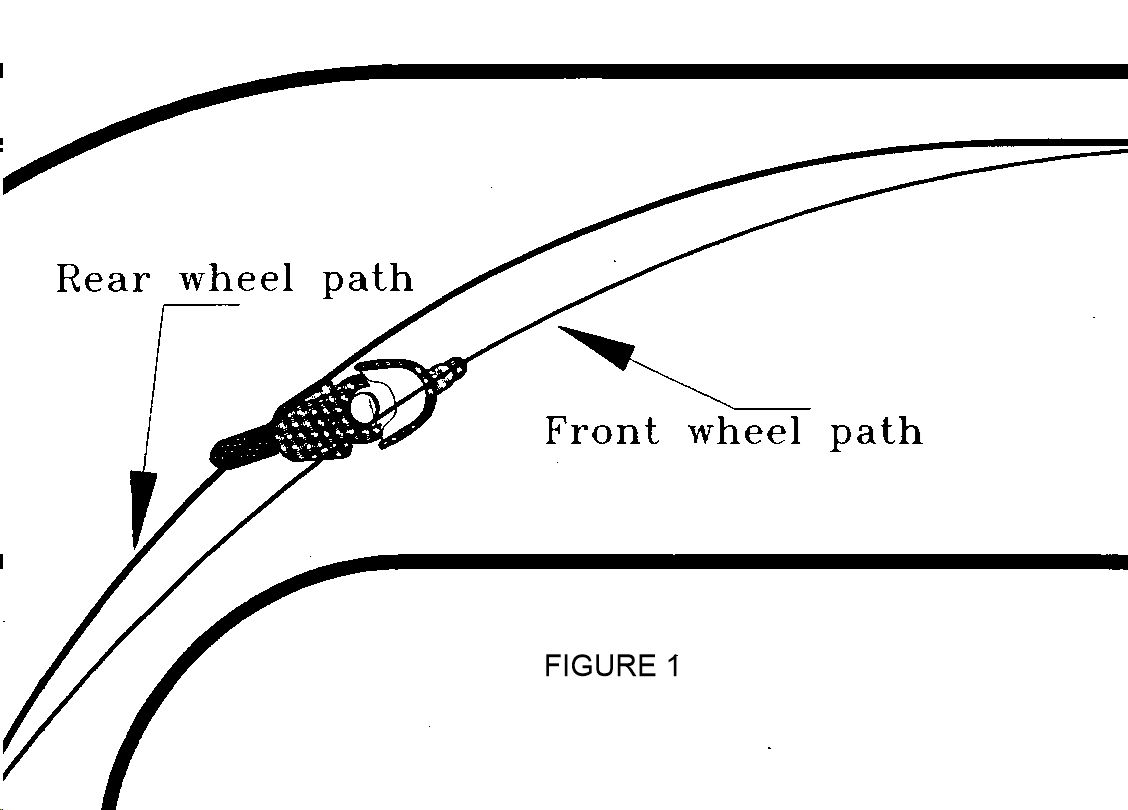
To site some examples, If you are familiar with drag racing, you know they leave the line with the rear wheels barely spinning. If the spin too much they "go up in smoke" and lose the match. If they don't spin at all, they will get beat again.
The same holds true for road racing. You must have the tire just at the verge of spinning, to know you have as much power applied as possible. It is certain the rider next to you on the track will be applying as much power as he can to beat you.
Another example of bikes using all of the traction is dirt racers, short track or mile. Both of these types of racers come out of the corner with the rear wheel hanging out. This allows a good drive onto the straight. To a small degree this is what a road racer is trying to do on pavement.
OBSERVE WHAT YOUR REAR WHEEL IS DOING
TO DETERMINE "HOW MUCH"
2. WHEN
The object is to achieve is "Maximum Throttle Time.” WHEN is very important because a split second delay will cost you acceleration off the turn and for the entire length of the straight. Conversely, too soon on the gas and you could run off the track at the exit.
To determine When, Cause and effect come into play here. The sooner and /or the more aggressive you apply the gas (cause), the wider your exit line will be (effect).
Figure # 2
Before you can make changes to improve you throttle application in the exit, You must observe several things,

- Observe where you are actually starting to roll on the gas,
- At the apex or before or after.
- Notice if you are running on the desired exit line (shown in Green). If you are then, take note of which you are doing in the exit,
- You will need to notice if you are maintaining the same lean angle through the entire exit
- Or are you actually easing up on the lean angle to allow the bike to drift to the outside edge.
- If you are not on the green line then notice if your exit line is mid track or tighter like the one shown in red, or somewhere in between (Grey).
Figure 3
This shows a basic concept of improving your drive off the corner. It shows the technique using only three steps to go from original throttle point to the final. Distances shown are not to any accurate scale of size or distance, this is to show the basic concept. The actual technique should take several small changes of the throttle point.
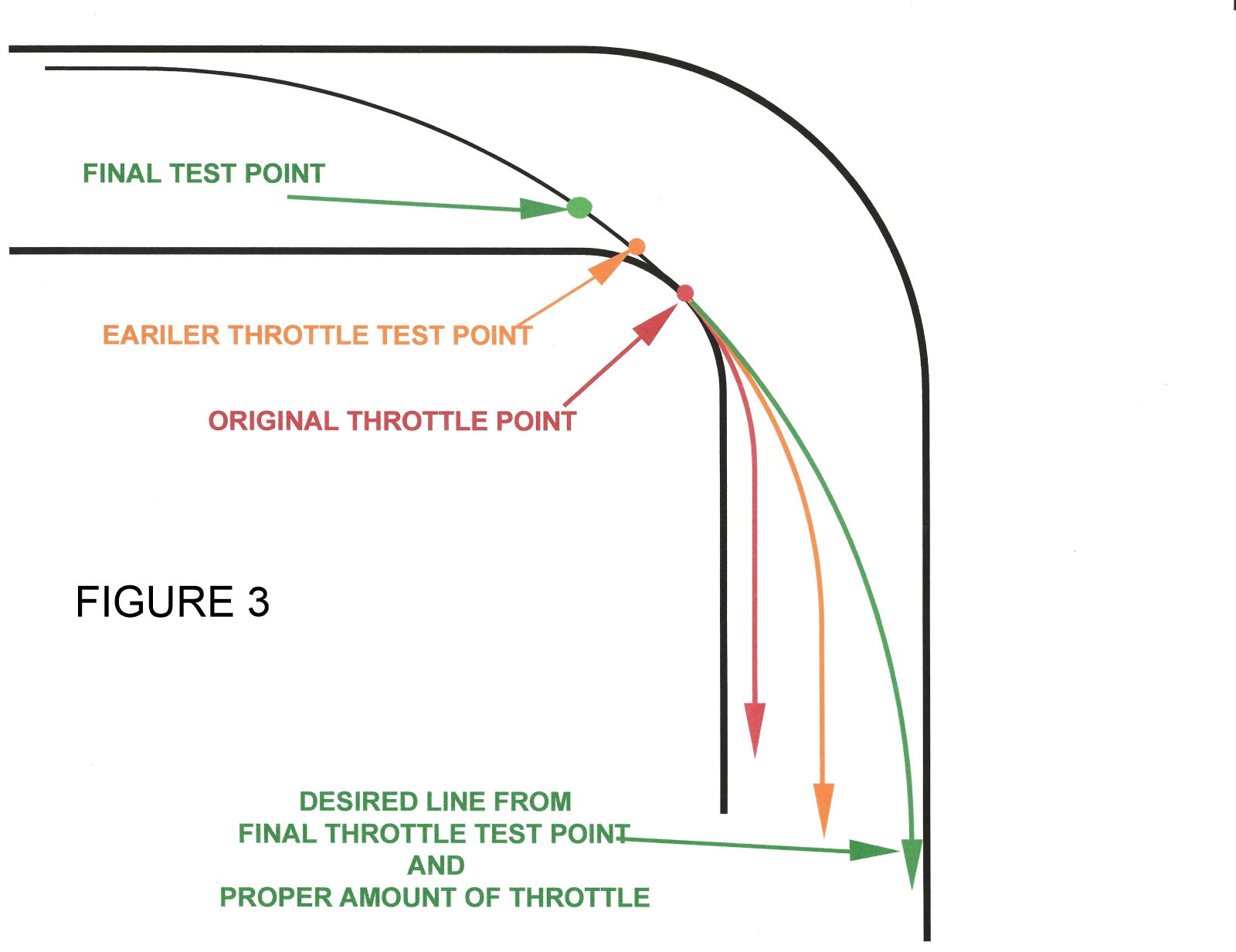
As you can see, in this example, from the original throttle point the exit line stays tight to the right and is not getting the best drive off. This can be the result of several factors, cover later. Notice as the rider turns the throttle on earlier, with everything else remaining the same, the bike is pushed further toward the outside edge.
The process
- Establish visual markers or reference points of your current actions.
- Once you are familiar with the details of your actions, then you can make some test changes and notice the results from each test.
- Hint, make only one change at a time. If you make several changes and the test doesn’t work, you won’t know with change worked or didn’t work.
- You will maintain the angle of lean and same amount of throttle, for each test point. The only variable you will change is where you roll into the throttle.
- Maintain the constant lean for the whole exit of the turn, until on the straight.
- If you can finish the turn low and tight to the inside edge (RED), then the next test point will be a few feet sooner.
- Each time you roll in a little earlier, you should find the bike drifting a little wider.
- Continue trying earlier and earlier throttle points until it is the acceleration pushing you all the way to the outside edge (GREEN) .
Figure 4
If you feel like you are going to run too wide, at the exit point, you can simply reduce you throttle slightly, while keeping the lean angle constant. This will let the bike tighten its line and not run off the outside edge.
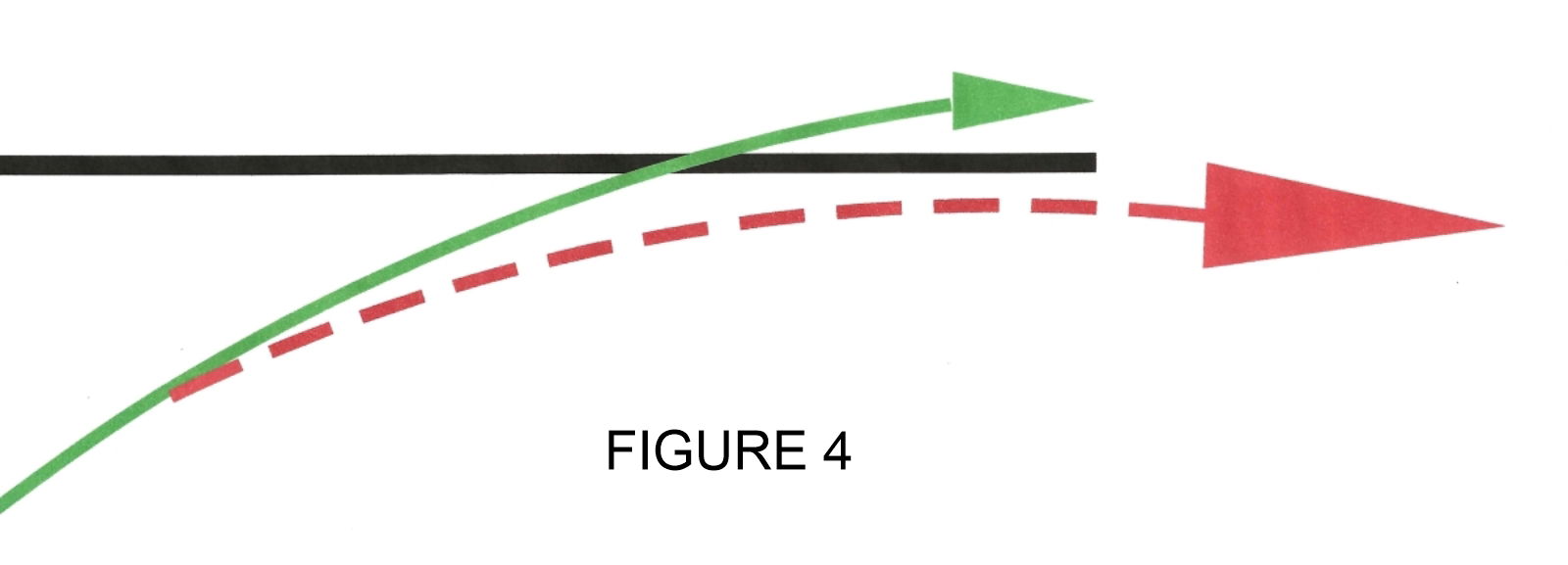
Figure 5
The goal is to have the acceleration carry you out to the edge of the pavement. For example, as you accelerate out of a right hand turn, the acceleration will force you to the extreme left edge of the track.
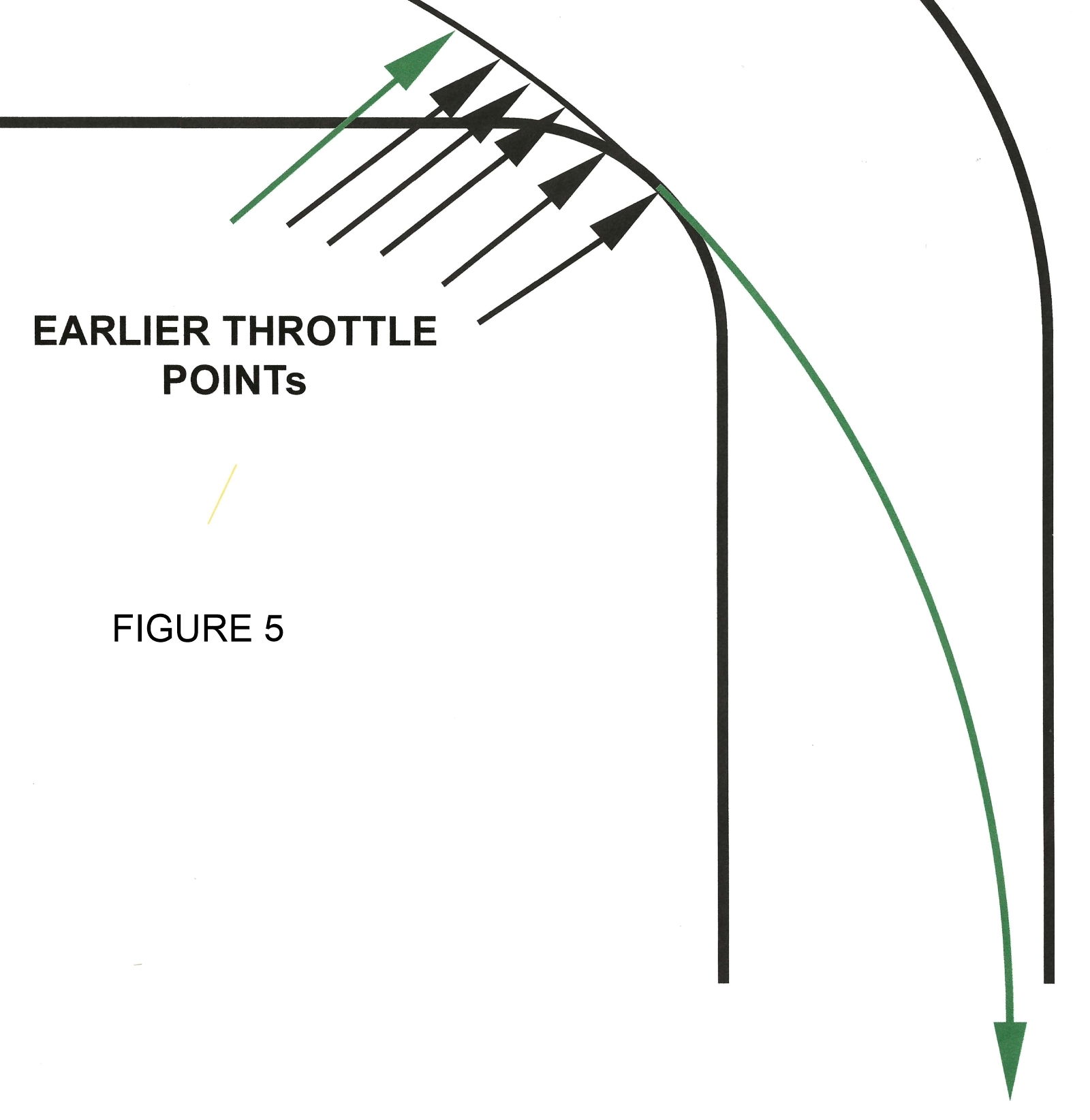
If you find yourself rolling out of the throttle to keep from running off the, as mentioned above, track, then you have throttled too soon.
An important detail to notice here is that in many cases, the final throttle point will be long before the apex of the turn. With most simple turns the optimal throttle point, with proper amount of throttle, would be at the apex. In this example, with the final test point (GREEN) well before the apex it is indictive of an entry that is too slow.
OBSERVE YOUR EXIT LINE TO DETERMINE "WHEN"
Extra benefit of this technique. When learning a new track, it is a good idea to figure out the throttle control, to get a good exit before trying to be too aggressive on entry speed. If you know you have an exit plan for the turn, it will be easier to work on higher entry speed with more confidence.
THE NEXT TASK, WORK ON ENTRY SPEED
IMPROVING ENTRY SPEED
Figure 6
For this example, we will look at a typical 90° turn with a 60MPH mid corner speed. Disclaimer, the numbers and distances shown in the following sketches are not to any scale and are just examples of the concept. Actual distances & speeds may be different.

If you are at the apex doing 60mph and pointed in the right direction, you can now start your drive off.
In most simple turns, you only need to be at mid corner speed at “MID CORNER by the apex. A lot of newbees have a good mid corner but they are at that speed for the entire corner instead of just at mid corner.
Figure 7 A,B,C
After accomplishing a good competitive exit line & speed. Notice your “Best Early Throttle Point” which gives you the desired exit line, is it well before the apex (“B”)?

When you can start to accelerate at the early throttle point (“B”), it means your entry speed and you are actually below the mid corner speed before you get to mid corner. What happens, when you accelerate at the early point, you eventually get back to the midcorner speed as you reach the apex shown in (“B”).
The task now is to increase you entry speed. As your entry speed increases the “Earlier” throttle point will need to be moved closer and closer back toward the apex. This process continues until you are slowing all the way from the turning point all the way to the apex. As you can see in (“C”), the resulting speed, at what was your best earlier throttle point, is now still higher than the midcorner speed. You continue to slow to the proper midcorner speed at apex.
Conclusion
There is a benefit of improving your exit and your drive off before trying to improve entry speed. Just trying to increase entry speed first, may be a little intimidating. In this situation, first you should develop good the exit of turn. Once you are comfortable because you have an exit plan, you can now be a little more comfortable working on higher entry speed.